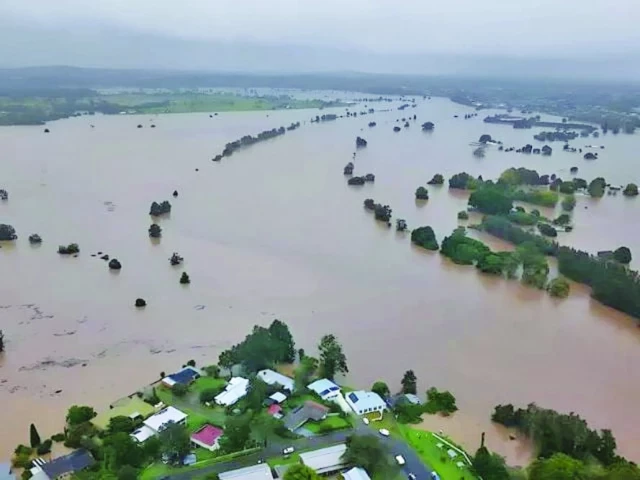LAHORE:
Pakistan is staring down the barrel of a food security emergency that could ripple through every layer of its economy. The catastrophic monsoon floods of 2025 have submerged vast swathes of the country, from Punjab’s wheat belt to Sindh’s rice-growing districts and parts of Khyber-Pakhtunkhwa.
Over 2,000 villages have been inundated, displacing millions, wrecking farmland, and wiping out critical infrastructure just as the summer harvest reached its peak.
The destruction is staggering. Entire standing crops of wheat, cotton, rice, maize, and sugarcane have been destroyed. In Punjab alone, 80% of the country’s wheat production is now at risk. Sindh’s rice fields and fodder supplies are underwater, while Khyber-Pakhtunkhwa has lost tens of thousands of acres of maize and vegetables.
Livestock losses are mounting, with fodder destroyed and surviving cattle starving. Farmers are reporting personal losses in the millions, collectively wheat farmers alone have seen over Rs2.2 trillion wiped out since last year.
The ripple effects are already visible in markets nationwide. In Lahore, Karachi, and Peshawar, staple food prices have spiked 30% to 70%, with shortages of vegetables, milk, and meat now commonplace.
For urban consumers, the pinch is immediate and painful. For rural producers, the pain is existential, as fields, homes, livestock, and seed stores have been swept away.
Tens of thousands of families now live in makeshift camps, with their livelihoods gone and no clear path to recovery. If left unsupported, millions risk falling below the poverty line, a repeat of the 2022 floods which pushed nine million Pakistanis into poverty, according to World Bank estimates.
The economic stakes are immense. Agriculture contributes 24% of Pakistan’s GDP and employs 40% of the workforce. The loss of this year’s harvest will not just hurt farmers; it will force Pakistan to import vast quantities of wheat, vegetables, and cotton, straining foreign exchange reserves and driving up the import bill.
At the same time, export earnings will collapse as rice and cotton surpluses disappear. This dangerous combination, higher imports and falling exports, threatens to widen the current account deficit and weaken the rupee.
Inflation, which had eased to 4.1% in July 2025 after painful reforms, is now set to surge again. Government officials are bracing for food inflation to return to double digits by October, with shortages of wheat and fresh produce driving price shocks. Urban and rural consumers alike will feel the squeeze, and political tensions are certain to rise as household budgets buckle under the pressure.
The floods also pose a fiscal nightmare. Relief and reconstruction costs will run into hundreds of billions of rupees, forcing the government to divert funds from other priorities or take on new debt. Under an IMF programme, fiscal space is already limited. Every rupee spent on relief is a rupee not spent on development, creating a vicious cycle of stagnation and instability.
Making matters worse, policy missteps have amplified the crisis. At the very moment when Pakistan needed stability and strategic reserves, the government moved to dismantle Passco, the only institution capable of safeguarding emergency wheat stocks and stabilising prices. Passco’s warehouses, which once held two million tons of grain, are being liquidated under IMF dictates.
Simultaneously, the abolition of the Utility Stores Corporation has stripped millions of poor households of access to subsidised food. This has left farmers at the mercy of profiteering cartels and consumers defenseless against runaway inflation.
The World Bank’s latest report warns that climate shocks are now the single biggest threat to Pakistan’s macroeconomic stability. Floods are no longer rare, one-off events, they are recurring economic shocks that depress growth, widen deficits, and push millions into poverty. The 2025 disaster is a textbook case – rising inflation, mounting imports, shrinking exports, and deepening social instability.
There are still steps that can prevent a slide into famine. Emergency imports of wheat and vegetables, temporary price controls, and targeted cash transfers to vulnerable families can stabilise the situation in the short term. Equally critical is direct support for farmers – seeds, fertiliser, and credit must be provided immediately so the upcoming Rabi winter wheat crop is not lost. Without this, Pakistan will face even deeper import dependency and food insecurity in 2026.
Longer term, Pakistan must finally invest in climate resilience. Flood defences, drainage systems, climate-smart seeds, and reliable strategic reserves are not luxuries; they are necessities for national security. As the World Bank notes, economic planning must now treat climate volatility as a core structural challenge, not a peripheral issue.
The 2025 floods are not just another disaster. They are a stark warning. If Pakistan does not act decisively, this year’s tragedy will not only wash away crops and homes, it will erode the very foundations of our economy and leave the nation vulnerable to the next inevitable shock.
The writer is a graduate of the University of British Columbia

